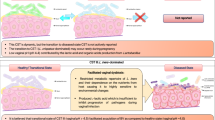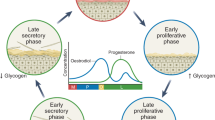Abstract
The notion of a protective vaginal flora is relatively new. Resident flora manifest colonization resistance to prevent or reduce the likelihood of exogenous microorganisms, viruses, bacteria, yeast, or parasites becoming established in the lower genital tract of women following sexual (HIV, Neisseria gonorrhoeae, Escherichia coli, Candida albicans, Trichomonas vaginalis) or nonsexual (uropathogenic E. coli) transmission. The concept of preserving or reestablishing protective flora has been hastened by several factors, including the potential widespread use of vaginal microbicides, the increased heterosexual spread of HIV, and the imminent availability of exogenous Lactobacillus species probiotic therapy.
Similar content being viewed by others
References and Recommended Reading
Richardson BA, Martin HL Jr, Stevens CE, et al.: Use of nonoxynol-9 and changes in vaginal lactobacilli. J Infect Dis 1998, 178:441–445.
Eschenbach DA, Davick PR, Williams BL, et al.: Prevalence of hydrogen peroxide-producing Lactobacillus species in normal women and women with bacterial vaginosis. J Clin Microbiol 1989, 27:251–256.
Hill G, Eschenbach DA, Holmes KK: Bacteriology of the vagina. Scand J Urol Nephrol 1985, 6:23–29.
Larsen B: Vaginal flora in health and disease. Clin Obstet Gynecol 1993, 36:107–121.
Klebanoff SJ, Watts H, Mehlin C, Headley CM: Lactobacilli and vaginal host defense: activation of the human immunodeficiency virus type 1 long terminal repeat cytokine production and NA-kB. J Infect Dis 1999, 179:653–660. Original in vitro study using lymphocyte and macrophage cell tissue culture lines examining the mechanism of action and interaction of lactobacilli, HIV, and cytokines, shedding new light on vaginal host defenses.
Klebanoff SJ, Hillier SL, Eschenbach DA, Waltersorph AM:Control of the microbial flora of the vagina by H202-generating lactobacilli. J Infect Dis 1991, 164:94–100.
Klebanoff SJ, Coombs RW: Viricidal effect of Lactobacillus acidophilus on human immunodeficiency virus type 1: possible role in heterosexual transmission. J Exp Med 1991, 174:289–292.
Redondo-Lopez V, Cook RL, Sobel JD: Emerging role of lactobacilli in the control and maintenance of the vaginal bacterial microflora. Rev Infect Dis 1990, 12:856–872.
Hawes SE, Hillier SL, Schenbach DA, Waltersdorph AM:Hydrogen peroxide-producing lactobacilli and acquisition of vaginal infections. J Infect Dis 1996, 174:1058–1063.
Hillier SL, Krohn MA, Lebanoff ST, Eschenbach DA:The relationship of hydrogen peroxide-producing lactobacilli to bacterial vaginosis and genital microflora in pregnant women. Obstet Gynecol 1992, 79:369–373.
Hillier SL, Krohn MA, Rabe LK, et al.: The normal vaginal flora, H2O2-producing lactobacilli, and bacterial vaginosis in pregnant women. Clin Infect Dis 1993, 16(suppl):273–281.
Sewankambo N, Gray RH, Waiver MJ, et al.: HIV-1 infection associated with abnormal vaginal flora morphology and bacterial vaginosis. Lancet 1997, 350:546–550. Cross-sectional study of rural women in Uganda demonstrated a positive association between abnormal vaginal flora and HIV-1 seropositivity, and a dose-response relationship between degree of microflora alteration and HIV-1 serostatus.
Klebanoff SJ: Effects of the spermicidal agent nonoxynol-9 on vaginal microbiol flora. J Infect Dis 1992, 165:19–25.
McGroarty JA, Tomeczek L, Pond DG, et al.: Hydrogen peroxide production by Lactobacillus species: correlation with susceptibility to the spermicidal compound nonoxynol-9. J Infect Dis 1992, 165:1142–1144.
Tomeczek L, Reid G, Cuperus PL, et al.: Correlation between hydrophobicity and resistance to nonoxynol-9 and vancomycin for urogenital isolates of lactobacilli. FEMS Microbiol Lett 1992, 73:101–104.
Hooton TM, Fennell CL, Clark AM, Stamm WE: Nonoxynol-9, differential antibacterial activity and enhancement of bacterial adherence to vaginal epithelial cells. J Infect Dis 1991, 164:1216–1219.
Gupta K, Stapleton AE, Hooton TM, Roberts PL, et al.: Inverse association of H202-producing lactobacilli and vaginal Escherichia coli colonization in women with recurrent urinary tract infections. J Infect Dis 1998, 178:446–450. Cross-sectional study in women with recurrent UTIs and controls correlating vaginal introital colonization of uropathogenic E. coli and concomitant presence of lactobacilli, especially H2O2-positive strains. Absence of H2O2-positive lactobacilli appeared to facilitate E. coli introital colonization..
Pfau A, Sacks T: The bacterial flora of the vaginal vestibule, urethra and vagina in premenopausal women with recurrent urinary tract infection. J Urol 1981, 126:630–634.
Stamey TA, Sexton CC: The role of vaginal colonization with Enterobacteriaceae in recurrent urinary tract infection. J Urol 1975, 113:214–217.
Hooton TM, Fihn SD, Johnson C, et al.: Association between bacterial vaginosis and acute cystitis in women using diaphragms. Arch Intern Med 1989, 149:1932–1936.
Hooton TM, Hillier S, Johnson C, et al.: Escherichia coli bacteriuria and contraceptive method. JAMA 1991, 265:64–69.
Reid G, Bruce AW, Cook RL: Effect on urogenital flora of antibiotic therapy for urinary tract infections. Scand J Infect Dis 1990, 22:43–47.
Bruce AW, Reid G, McGroarty JA, et al.: Preliminary study on the prevention of recurrent urinary tract infection in adult women using utravaginal lactobacilli. Int Urogynecol J 1992, 3:22–25.
Baerheim A, Larsen E, Digranes A: Vaginal application of lactobacilli in the prophylaxis of recurrent lower urinary tract infection in women. Scand J Prim Health Care 1994, 12:239–243.
Raz R, Stamm WE: A controlled trial of utravaginal estriol in post-menopausal women with recurrent urinary tract infections. N Engl J Med 1993, 329:753–756.
Hughes VL, Hillier SL: Microbiologic characteristics of Lactobacillus products used for colonization of the vagina. Obstet Gynecol 1990, 75:244–248.
Hilton E, Isenberg HD, Alperstein P, et al.: Ingestion of yogurt containing Lactobacillus acidophilus as prophylaxis for candidal vaginitis. Ann Intern Med 1992, 116:353–357.
Auger P, Jolly J: Microbial flora associated with Candida albicans vulvovaginitis. Obstet Gynecol 1980, 55:397–401.
Sobel JD, Chaim W: Vaginal microbiology of women with acute recurrent vulvovaginal candidiasis. J Clin Microbiol 1996, 34:2497–2502.
Pavlova SI, Kilic AO, More SM, Tao L: Phage infection in vaginal lactobacilli: an in vitro study. Infect Dis Obstet Gynecol 1998, 6:236–240.
Voller B, Anderson DJ: Heterosexual transmission of HIV [letter]. JAMA 1992, 267:1917–1918.
Taha TE, Hoover DR, Dallabetta GA, et al.: Bacterial vaginosis and disturbances of vaginal flora: association with increased acquisition of HIV. AIDS 1998, 12:1699–1706. Longitudinal follow-up study of pregnant and postpartum women in Malawi in which disturbance in vaginal flora as exemplified by bacterial vaginosis increased HIV acquisition.
Paavonen J, Critchlow CW, De Rouen T, et al.: Etiology of cervical inflammation. Am J Obstet Gynecol 1986, 154:556–564.
Zheng H, Alcom TM, Cohen MS: Effect of H202-producing lactobacilli on Neisseria gonorrhoeae growth and catalase activity. J Infect Dis 1994, 170:1209–1215.
Author information
Authors and Affiliations
Rights and permissions
About this article
Cite this article
Sobel, J.D. Is there a protective role for vaginal flora?. Curr Infect Dis Rep 1, 379–383 (1999). https://doi.org/10.1007/s11908-999-0045-z
Issue Date:
DOI: https://doi.org/10.1007/s11908-999-0045-z




